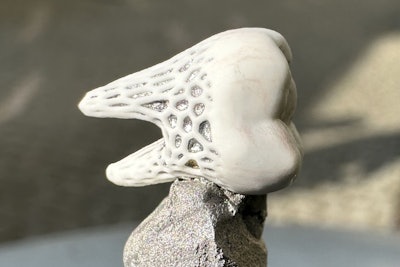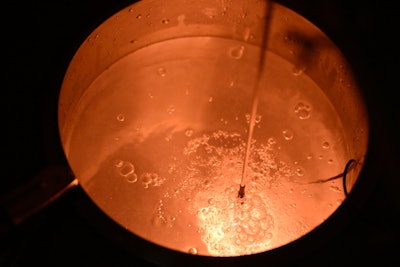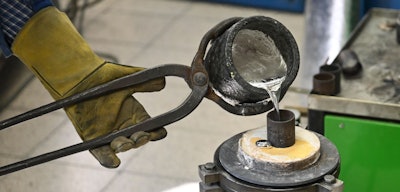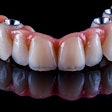International researchers are attempting to create fake teeth that, with the help of biodegradable magnesium, will grow into a perfectly fitting dental implant, according to a press release from Wroclaw University of Science and Technology in Poland.
Researchers from Wroclaw and the National Taipei University of Technology in Taiwan are behind the research for tailor-made implant, which will have a solid ceramic crown, while the lower part will have a metal core with open porosity, allowing for it to be saturated with magnesium alloy.
 The upper part of the crown features a solid ceramic structure, whereas the root is porous. Due to this structure, the roots can be saturated with a liquid metal, such as a magnesium alloy, that is designed to reduce the fragility of the crown while acting as an anchor. Images and captions courtesy of Wroclaw University of Science and Technology.
The upper part of the crown features a solid ceramic structure, whereas the root is porous. Due to this structure, the roots can be saturated with a liquid metal, such as a magnesium alloy, that is designed to reduce the fragility of the crown while acting as an anchor. Images and captions courtesy of Wroclaw University of Science and Technology.
The liquid metal makes the structure less fragile, allowing it to anchor into the jaw. Over time, the magnesium degrades, freeing up space for bone tissue to grow and further stabilizing and embedding the implant, according to the release.
 Magnesium is a difficult casting material due to its high reactivity. It also easily oxidizes when exposed to air or plaster. To create the implant prototype, researchers took careful steps to create the alloy. The material is subjected to a high electrical voltage that causes plasma discharges on the surface that then forms a thin coating of magnesium oxide that can be used. The magnesium coating has anticorrosion properties, is resistant to abrasion, and for dental implants, it slows the resorption of magnesium into the body.
Magnesium is a difficult casting material due to its high reactivity. It also easily oxidizes when exposed to air or plaster. To create the implant prototype, researchers took careful steps to create the alloy. The material is subjected to a high electrical voltage that causes plasma discharges on the surface that then forms a thin coating of magnesium oxide that can be used. The magnesium coating has anticorrosion properties, is resistant to abrasion, and for dental implants, it slows the resorption of magnesium into the body.
"A composite implant with interpenetrating reinforcement and matrix phases is a new approach," Anna Dmitruk, PhD, of Wroclaw, said in the release. "Until now, two different materials, ceramics and metal, were combined in implants, e.g., by means of a screw connection. Our project involves the creation of a composite, i.e., one material, but with a heterogeneous structure and very complex shapes. Filling such a lace structure with metal, as we propose in our project, would not be possible in any other way."
Currently, two casting techniques are being tested.
Pressure infiltration, which precisely presses from the liquid state and the ceramic fitting is placed in the chamber of a press and poured with liquid metal. Then, the piston is lowered, and the liquid metal is pressed into the porosity of the preform, according to the release.
Precision casting, a technique that is used to make jewelry, creates a plaster mold from a ceramic preform. Then it is saturated with a selected alloy. During the firing of the mold, the preform is removed creating an empty space. The next step is to pour the metal to get the desired composite.
 Researchers at the Wroclaw University of Science and Technology and the National Taipei University of Technology are testing two different casting methods to create a 3D-printed ceramic crown connected to a metal alloy core.
Researchers at the Wroclaw University of Science and Technology and the National Taipei University of Technology are testing two different casting methods to create a 3D-printed ceramic crown connected to a metal alloy core.
Additionally, the researchers will continue to conduct tests, including strength connection quality, on the implant prototypes.
Finally, the research and the creation of the prototype will continue for three years. After the prototype implant is created, the researchers will seek funding for the next stages, including conducting premedical research.



















